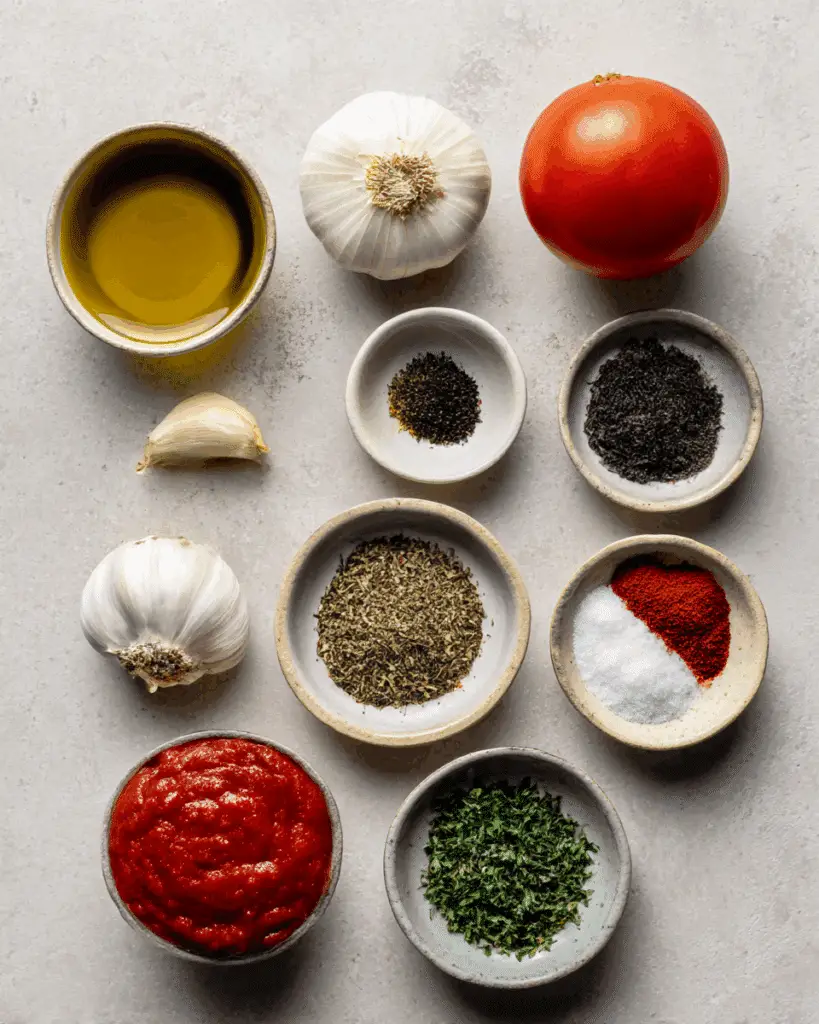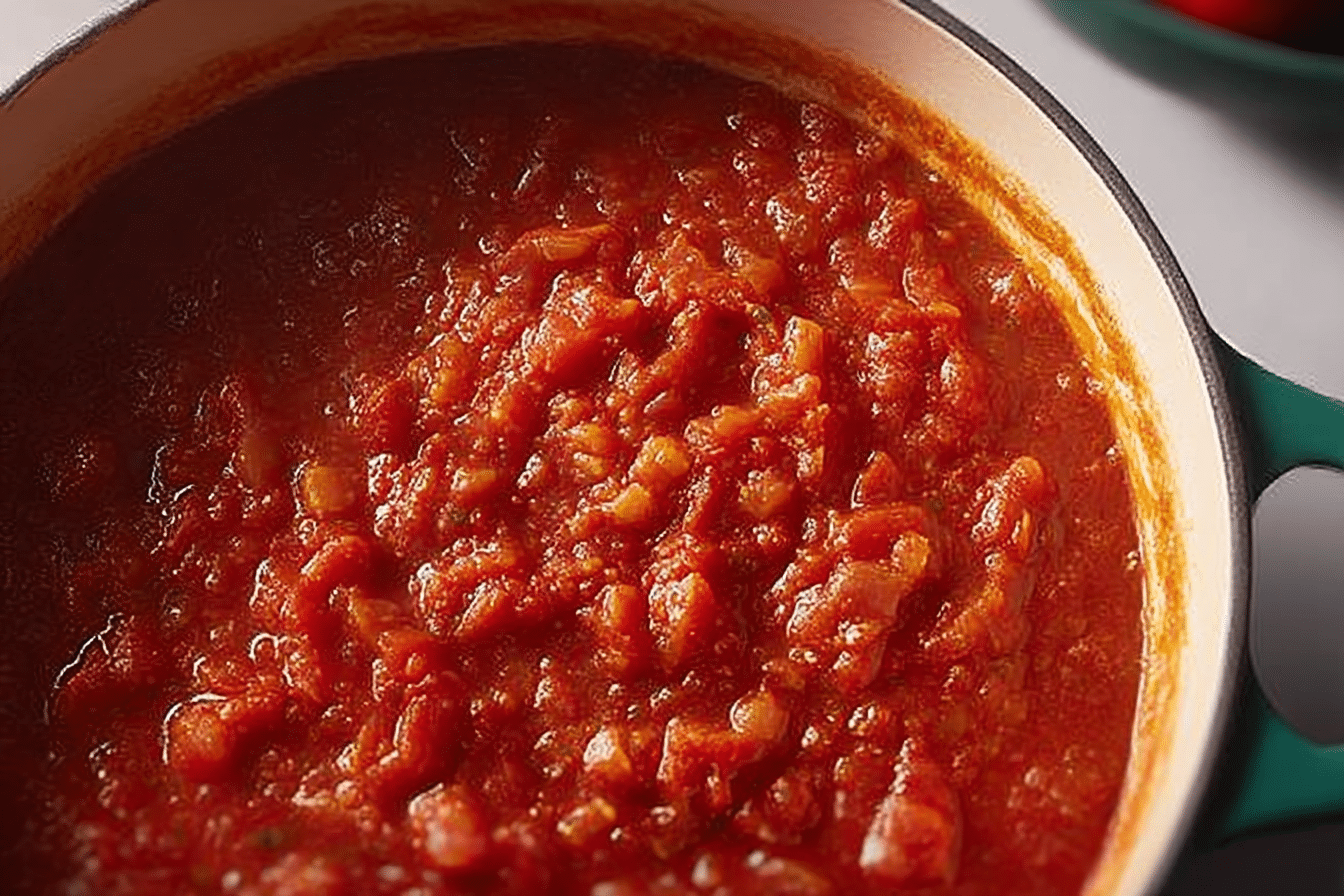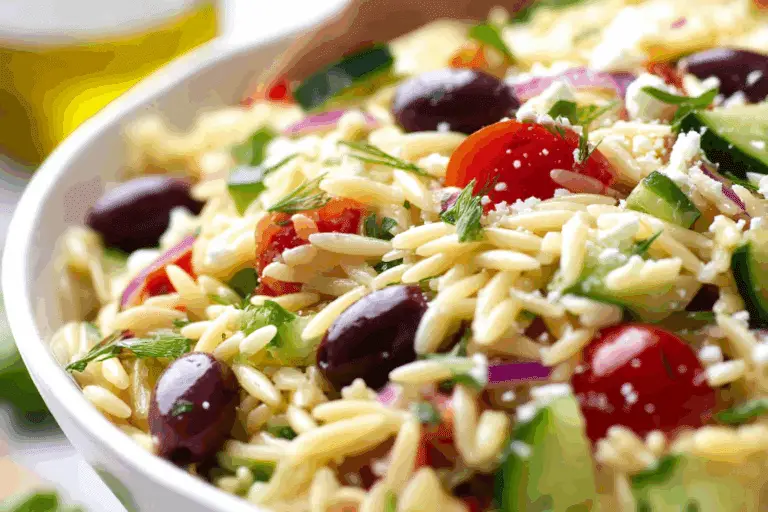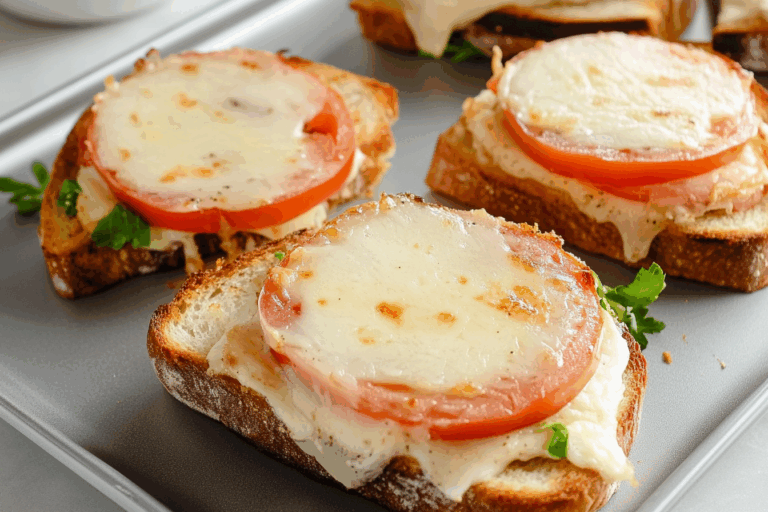Marinara
Simmering on the stove, rich with the scent of ripe tomatoes, garlic, and herbs, marinara sauce is the heart and soul of Italian comfort food. One whiff, and you’re transported to a sun-drenched kitchen in the south of Italy, where simplicity reigns and flavor is king. Glossy, ruby-red, and irresistibly fragrant, this sauce turns everyday meals into something extraordinary. It’s a staple worth mastering—and once you do, you’ll never reach for the jarred stuff again.
Behind the Recipe
Marinara sauce was one of the first things I learned to make from scratch, standing beside my Nonna as she stirred a pot of bubbling red gold. I remember the wooden spoon she always used, stained slightly pink from years of use. She would taste it every few minutes, adjusting with a pinch of salt or a splash of olive oil, her face lighting up when it was just right. It wasn’t just about the sauce—it was about the ritual, the patience, and the love you put into every stir. Today, I carry that tradition forward, and now, so can you.
Recipe Origin or Trivia
Marinara, meaning “sailor-style” in Italian, has roots in the coastal regions of Naples. Contrary to popular belief, it doesn’t include seafood—it was named after the wives of fishermen who prepared this sauce to welcome their husbands home from sea. The earliest versions were simple: tomatoes, garlic, olive oil, and herbs. No cream, no cheese, no sugar. Just fresh ingredients cooked slowly to perfection. This minimalist masterpiece laid the foundation for countless Italian dishes, from pasta and pizza to eggplant Parmesan and beyond.
Why You’ll Love Marinara
This sauce is more than a recipe—it’s a kitchen essential. Here’s why it’ll become your new favorite:
Versatile: Perfect for pasta, pizza, meatballs, or even as a dipping sauce.
Budget-Friendly: Made with pantry staples that are both affordable and accessible.
Quick and Easy: No need to simmer for hours—this version is ready in about 30 minutes.
Customizable: Adjust herbs, garlic, or add a touch of spice to suit your palate.
Crowd-Pleasing: Familiar, comforting flavors that everyone loves.
Make-Ahead Friendly: It tastes even better the next day after the flavors meld.
Great for Leftovers: Use it throughout the week in a variety of dishes.
Chef’s Pro Tips for Perfect Results
Take your marinara from good to unforgettable with these insider tricks:
- Use whole peeled San Marzano tomatoes for the richest flavor and best texture.
- Sauté the garlic gently until fragrant, not browned, to avoid bitterness.
- Simmer uncovered to allow the sauce to reduce and thicken naturally.
- Crush tomatoes by hand or use a potato masher for a rustic texture.
- Finish with a drizzle of good olive oil to deepen flavor and add richness.
Kitchen Tools You’ll Need
You’ll only need a few essentials to bring this classic sauce to life:
Large Saucepan or Skillet: Wide enough to allow the sauce to reduce evenly.
Wooden Spoon or Spatula: For stirring and breaking down the tomatoes.
Can Opener: If you’re using canned tomatoes.
Blender or Immersion Blender (optional): For a smoother finish if desired.
Measuring Spoons: Accuracy matters for balanced seasoning.
Ingredients in Marinara
This recipe relies on just a handful of ingredients, each playing a crucial role. Together, they create a sauce that’s vibrant, savory, and deeply satisfying.
- Whole Peeled Tomatoes: 800g can (preferably San Marzano), provides the base and sweetness.
- Garlic: 4 cloves, finely minced, infuses the sauce with rich aroma and flavor.
- Olive Oil: 3 tablespoons, used for sautéing and finishing—adds depth and body.
- Salt: 1 teaspoon, enhances all the natural flavors.
- Crushed Red Pepper Flakes: ¼ teaspoon, gives a subtle kick without overwhelming heat.
- Dried Oregano: 1 teaspoon, lends an earthy, herbal note.
- Fresh Basil: A handful, torn at the end, adds brightness and classic Italian flair.
- Black Pepper: ½ teaspoon, for balanced seasoning.
Ingredient Substitutions
No need to panic if you’re missing an item—here are some easy swaps:
Whole Peeled Tomatoes: Use crushed tomatoes or fresh Roma tomatoes, peeled.
Garlic: Garlic powder (½ teaspoon per clove) in a pinch.
Fresh Basil: Substitute with ½ teaspoon dried basil.
Olive Oil: Any neutral oil like avocado or sunflower.
Ingredient Spotlight
San Marzano Tomatoes: These Italian-grown beauties are prized for their low acidity, sweetness, and tender flesh—perfect for sauces.
Garlic: The soul of marinara, it adds warmth, depth, and a distinct savory note that anchors the sauce.

Instructions for Making Marinara
Making marinara is a sensory journey—full of aromas, textures, and flavor transformations. Here’s how to make it from scratch:
- Preheat Your Equipment:
Place a large skillet or saucepan over medium heat. - Combine Ingredients:
Add olive oil, then garlic and red pepper flakes. Sauté for 1–2 minutes until fragrant. - Prepare Your Cooking Vessel:
Ensure the heat is steady, not too high, to prevent burning the garlic. - Assemble the Dish:
Add tomatoes with their juices. Crush them gently with a spoon or your hands. Stir in salt, black pepper, and oregano. - Cook to Perfection:
Simmer uncovered for 20–30 minutes, stirring occasionally until thickened. - Finishing Touches:
Tear in fresh basil leaves, adjust seasoning, and drizzle with olive oil before removing from heat. - Serve and Enjoy:
Ladle over pasta, spoon onto pizza dough, or serve as a dipping sauce with crusty bread.
Texture & Flavor Secrets
What sets a great marinara apart is its balance—bright acidity from tomatoes, warmth from garlic, and herbaceous depth. The sauce should be slightly chunky, with soft bits of tomato that melt into the pasta. Letting it simmer uncovered helps intensify flavors while gently thickening the texture to that perfect, clingy consistency.
Cooking Tips & Tricks
Here are a few more secrets to level up your marinara:
- Simmer longer for deeper flavor—great for meal prep.
- Add a pinch of sugar only if your tomatoes are very acidic.
- Blend a portion of the sauce for a creamier texture while retaining some rustic charm.
What to Avoid
Avoid these common pitfalls for a flawless sauce:
- Don’t rush the garlic—it burns easily and becomes bitter.
- Avoid metal pots that react with tomato acid, use stainless steel or enamel.
- Don’t cover while simmering or you’ll miss out on flavor concentration.
Nutrition Facts
Servings: 4
Calories per serving: 120
Note: These are approximate values.
Preparation Time
Prep Time: 5 minutes
Cook Time: 25 minutes
Total Time: 30 minutes
Make-Ahead and Storage Tips
Marinara is a dream for prepping ahead. It stores beautifully in the fridge for up to 5 days in an airtight container and freezes well for up to 3 months. Let it cool before storing, and reheat gently on the stove, adding a splash of water if it thickens too much.
How to Serve Marinara
The options are endless. Toss it with spaghetti, layer it in lasagna, spoon it over roasted veggies, or use it as a pizza base. It also makes an amazing dip for mozzarella sticks, garlic bread, or fried zucchini. The possibilities are as endless as they are delicious.
Creative Leftover Transformations
Breathe new life into your leftover marinara:
- Stir into cooked rice with herbs for a quick tomato pilaf.
- Use as a base for tomato soup—just add stock and blend.
- Mix with cooked lentils or beans for a hearty vegetarian stew.
Additional Tips
- Keep some tomato paste on hand to thicken if needed.
- Fresh basil should always go in at the end to preserve its flavor.
- Let the sauce rest for a few minutes before serving—it deepens the taste.
Make It a Showstopper
Presentation elevates even the simplest dish. Serve marinara in a white bowl to contrast the rich red hue. Top with a swirl of olive oil, a fresh basil leaf, and a dusting of cracked pepper. Pair with artisan bread or pasta on a rustic wooden board for an eye-catching spread.
Variations to Try
- Spicy Arrabbiata: Add extra chili flakes or diced fresh chili.
- Roasted Garlic: Swap sautéed garlic for slow-roasted cloves.
- Herb-Infused: Add rosemary or thyme for a fragrant twist.
- Chunky Veggie: Stir in sautéed onions, bell peppers, or mushrooms.
- Olive and Capers: For a Puttanesca-inspired punch.
FAQ’s
Q1: Can I use fresh tomatoes?
Yes! Blanch, peel, and chop them first. Use about 1.5 kg for this recipe.
Q2: Is marinara the same as tomato sauce?
Not quite. Marinara is quicker, lighter, and usually doesn’t include meat or long simmering.
Q3: Can I freeze marinara?
Absolutely. Cool completely, then store in freezer-safe containers for up to 3 months.
Q4: Can I add wine?
Traditionally no, but a splash of red wine can deepen the flavor if desired.
Q5: How do I fix a bitter sauce?
Add a pinch of sugar or a small grated carrot to balance acidity.
Q6: What pasta goes best with marinara?
Spaghetti, penne, and rigatoni all work beautifully.
Q7: Can I make it oil-free?
Yes, sauté in a splash of broth instead of oil.
Q8: Should I blend the sauce?
Totally up to you. Leave it chunky or blend for smoothness.
Q9: How long should I simmer?
20–30 minutes is perfect, but longer for a more developed flavor.
Q10: Is it vegan?
Yes! This recipe is completely plant-based.
Conclusion
Marinara is more than just a sauce—it’s a celebration of simplicity and flavor. Whether you’re tossing it with pasta or dipping a crusty loaf of bread, this timeless Italian classic delivers comfort in every bite. Let me tell you, it’s worth every stir.
Print
Marinara
Description
A classic Italian tomato sauce bursting with garlic, herbs, and ripe tomato flavor. Marinara is quick to make, endlessly versatile, and perfect for pasta, pizza, or dipping.
Ingredients
- Whole Peeled Tomatoes: 800g can (preferably San Marzano) – provides the base and sweetness
- Garlic: 4 cloves, minced – infuses rich aroma and flavor
- Olive Oil: 3 tablespoons – adds depth and silkiness
- Salt: 1 teaspoon – enhances the natural flavors
- Crushed Red Pepper Flakes: ¼ teaspoon – brings subtle heat
- Dried Oregano: 1 teaspoon – offers herbal, earthy notes
- Fresh Basil: A handful, torn – adds brightness at the end
- Black Pepper: ½ teaspoon – for a gentle kick
Instructions
- Preheat Your Equipment: Heat a large skillet or saucepan over medium heat.
- Combine Ingredients: Add olive oil, garlic, and red pepper flakes. Sauté for 1–2 minutes until fragrant.
- Prepare Your Cooking Vessel: Ensure heat is medium to avoid burning garlic.
- Assemble the Dish: Pour in tomatoes with juices. Crush gently, then stir in salt, pepper, and oregano.
- Cook to Perfection: Simmer uncovered for 20–30 minutes, stirring occasionally until thickened.
- Finishing Touches: Tear in basil and drizzle with olive oil. Taste and adjust seasoning.
- Serve and Enjoy: Pair with pasta, pizza, or crusty bread.
Notes
- Simmer longer for deeper flavor.
- Add a pinch of sugar if your tomatoes are too acidic.
- Use an immersion blender for a smooth texture.







